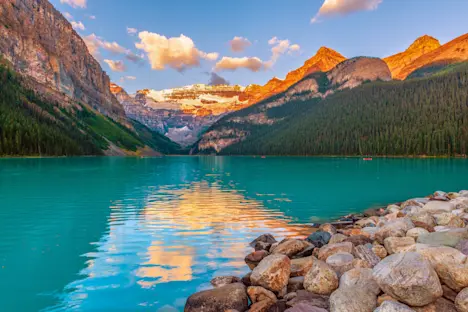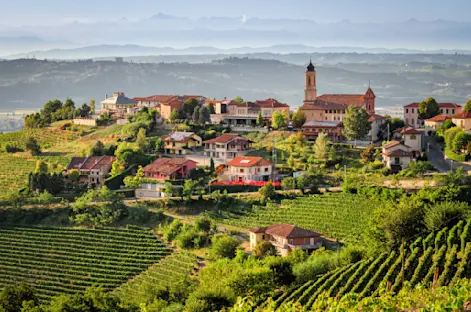
Know Before You Go: Alaska Adventures


Wildlife in Alaska – What Animals Will I See?
Alaska is one of the best places in the world for wildlife viewing. With vast ecosystems ranging from tundra to temperate rainforest, visitors can encounter an incredible diversity of animals, including grizzly bears, moose, whales, caribou, puffins and wolves. Whether you’re watching brown bears fish for salmon or spotting sea otters among coastal kelp, Alaska's wildlife experiences are unforgettable.
Bears of Alaska
Three species of bears roam Alaska: brown bears (often called grizzlies), black bears and polar bears.
Brown bears: Fpimd om Katmai and Lake Clark National Parks (especially during July-September salmon runs)
Black bears: Smaller and more elusive, found throughout interior and coastal forests
Polar bears: Best seen near Kaktovik along the Arctic coastline in late summer and fall
What’s the Best Way to See Grizzly Bears in the Wild in Alaska?
The best way to see grizzlies in the wild is through guided bear-viewing trips to Katmai or Lake Clark. Expert naturalist guides lead travelers to prime viewing sites, often accessed by floatplane..
"Nat Hab’s Alaska Bear Camp is a remote, off-grid sustainable base camp in one of the wildest places on Earth. Set along the shores of Lake Clark National Park and Preserve, the expedition team is comprised of bear naturalists and professional photographers working in tandem with World Wildlife Fund." —Forbes
Moose, Caribou and Other Mammals
Alaska’s wilderness hosts iconic large mammals and secretive predators across tundra, forest, and alpine terrain.
Moose — Towering herbivores that roam wetlands, lakeshores and spruce forests; often seen alone or with calves, especially in areas like Denali National Park
Caribou — Nomadic herd animals that travel hundreds of miles each year across tundra and taiga; follow traditional migration corridors shaped over millennia
Wolves — Social predators that live in packs; range across Denali National Park and northern wilderness regions; most active at dawn and dusk
Foxes — Red, Arctic and cross foxes inhabit tundra, forest and shoreline; known for their agility, curiosity and seasonal coat changes
Lynx — Elusive, solitary cats adapted to cold climates; recognizable by their tufted ears and large paws; found in forested areas across interior Alaska
Dall sheep — Sure-footed white sheep with curled horns; commonly spotted on steep cliffs and alpine ridges in Denali and Wrangell-St. Elias
Mountain goats — Thick-coated climbers with short horns; inhabit rocky slopes and glaciers in coastal ranges like Kenai and Chugach
Beavers — Skilled aquatic engineers that build lodges and dams in forested wetlands; active year-round and often seen at dawn or dusk
Marine Wildlife in Alaska
Alaska’s coastal waters host an incredible diversity of marine life. Humpback whales migrate here in summer to feed on krill and small fish, often breaching and bubble-net feeding in full view of onlookers. Orcas are frequently seen in Southeast Alaska, hunting in pods and cruising alongside boats. Sea otters float belly-up in kelp beds, using rocks to crack open clams, while puffins dig burrows on windswept cliffs above the sea. Other marine mammals—like harbor seals, Steller sea lions and porpoises—add to the richness of Alaska’s marine ecosystems. Tidewater glaciers calve icebergs into waters teeming with plankton, which in turn draw fish, birds and mammals from every link of the food chain.
Whales to Watch For
Humpbacks — Most commonly seen in the Kenai Fjords and Inside Passage from May to September
Orcas — Often travel in pods throughout Southeast Alaska, especially near Sitka, Juneau and Glacier Bay
Gray whales — Seen during spring migration along the Aleutian Islands and Bering Sea coast
Other Marine Highlights
Sea otters — Raft together in kelp beds; common in Prince William Sound and Kodiak
Steller sea lions — Large, vocal groups haul out on rocky islands and coastal haulouts
Harbor seals — Haunt ice floes and glacier bays, often seen lounging near tidewater glaciers
Dall’s porpoises — Fast-moving, black-and-white porpoises often seen riding boat wakes
Puffins — Tufted and horned puffins nest in large colonies on coastal cliffs throughout the Gulf of Alaska
Birding in Alaska
Alaska is one of the best birding destinations in North America, with more than 500 recorded species across its vast and varied ecosystems. Alaska’s coastal cliffs, boreal forests, tundra plains and wetlands attract both migratory and resident birds.
Bald eagles — Common along coastal shorelines and salmon-rich rivers throughout summer and early fall
Puffins — Nest in large colonies on coastal cliffs in Kenai Fjords, Chiswell Islands and Kodiak
Sandhill cranes — Seen in Copper River Delta, Matanuska-Susitna Valley and Tanana Flats during spring (April–May) and fall (August–September) migrations
Loons and grebes — Nest on interior lakes in Denali and Lake Clark
Owls — Great gray, snowy and boreal owls thrive in tundra and taiga, most visible in fall and winter
Shorebirds and waterfowl — Peak viewing at Potter Marsh, Yukon-Kuskokwim Delta and Arctic National Wildlife Refuge during spring migration
Wildlife Photography in Alaska
For nature photographers, Alaska is one of the world’s best destinations. The variety and proximity of wildlife, dramatic lighting and vast landscapes offer endless inspiration. Whether capturing the action of bears fishing or the elegance of whales breaching, each encounter offers a unique story to tell.
Top Wildlife Moments to Photograph in Alaska
Bears fishing for salmon — Brooks Falls, Latmai; Chinitna Bay, Lake Clark
Whales breaching against glacier backdrops — Kenai Fjords and Southeast Alaska
Puffins nesting — Kenai Fjords, Kodiak and the Pribilof Islands
Caribou migrations — Denali and the Arctic Refuge and interior valleys
Bald eagles soaring over rivers — Widespread along coastlines and salmon streams
Foxes, moose and wolves — Often spotted near backcountry lodges and protected parklands
What are the best times and places for wildlife viewing?
Alaska's wildlife viewing peaks during its short summer season. Different species shine in each month.
Months | Highlights |
|---|---|
May–June | Migrating birds, whales arriving, newborns, wildflowers |
July–August | Bears fishing for salmon, peak whale activity, puffins nesting |
September | Fat bears, caribou migration, northern lights, fewer crowds |
Wildlife FAQs
Where can I see bears fishing for salmon in Alaska?
You can see bears fishing for salmon in Katmai and Lake Clark national parks, especially during the peak summer runs. These world-renowned brown bear habitats offer extraordinary viewing of bears catching salmon in rivers and waterfalls. At Brooks Falls in Katmai, bears gather in high numbers to fish at the famous viewing platform. In Lake Clark, remote spots like Chinitna Bay also provide excellent sightings, often with fewer people.
Can I see puffins in Alaska?
Yes—tufted and horned puffins nest on Kenai Fjords, Kodiak Island, the Pribilof Islands and Chiswell Islands from May through August. Boat tours and cliffside hikes offer excellent viewing.
Are there polar bears in Alaska?
Yes—polar bears inhabit the Arctic coast near Kaktovik and Barter Island. Guided, conservation-focused tours in late summer and fall offer the best—and safest—viewing opportunities.
When is the best time for Alaska wildlife viewing?
May to September is ideal for most wildlife. Spring brings migratory birds and whales, summer features salmon-feeding bears and nesting puffins, and fall showcases caribou migrations and the northern lights.
What are the best Alaska wildlife tours?
Small-group tour companies like Natural Habitat Adventures offer expert naturalist guides, remote wilderness access and conservation-focused travel. Tours often include floatplane flights, backcountry lodges and exclusive bear-viewing sites.
How does responsible travel support Alaska's wildlife and or local communities?
Wildlife tours that partner with World Wildlife Fund, Indigenous guides and local communities help protect fragile ecosystems while supporting rural economies and cultural heritage.
Learn More About Alaska Wildlife
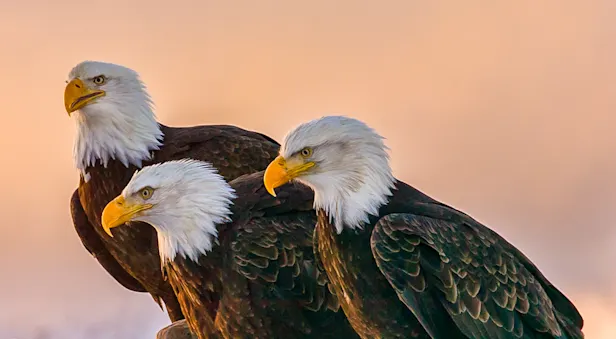
Bald Eagle
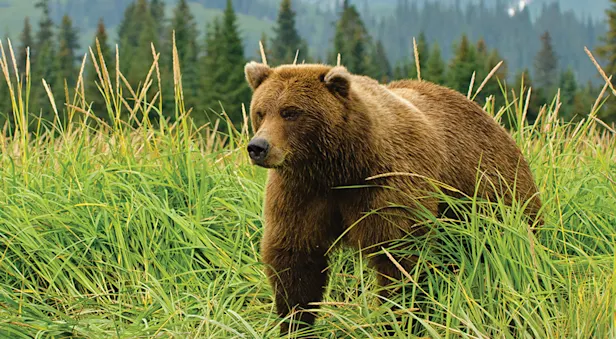
Brown Bear
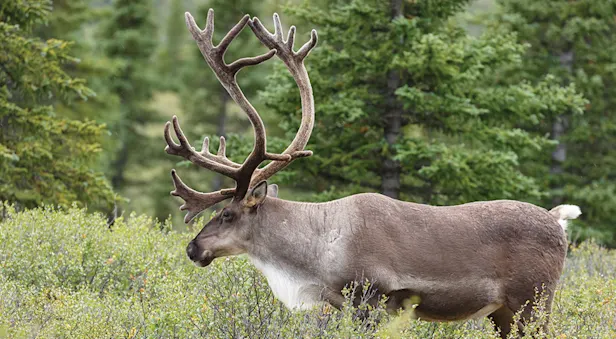
Caribou
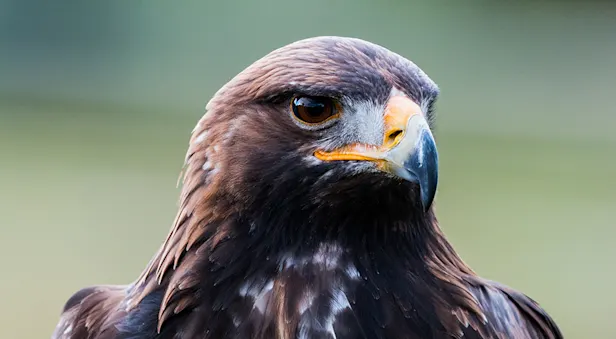
Golden Eagle

Humpback Whale
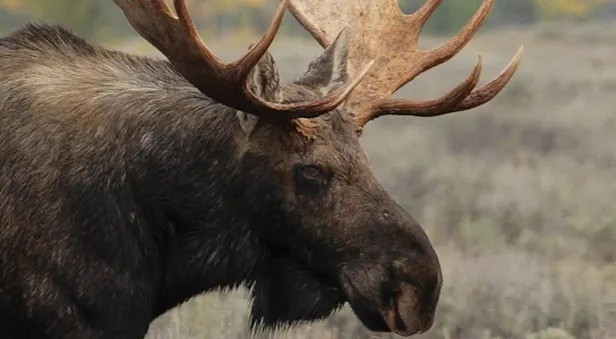
Moose
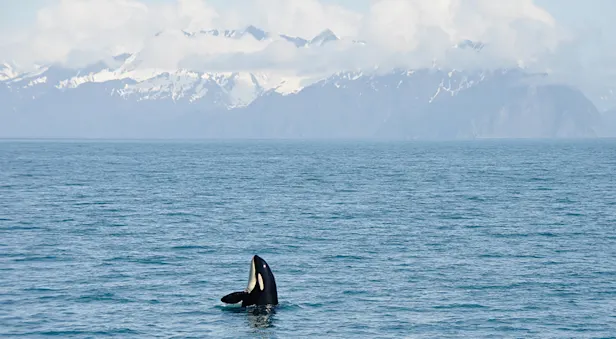
Orca

Puffin
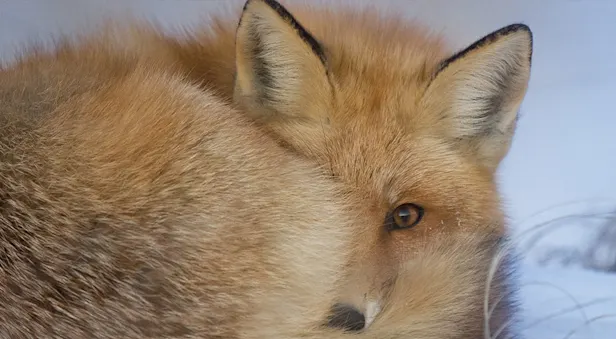
Red Fox
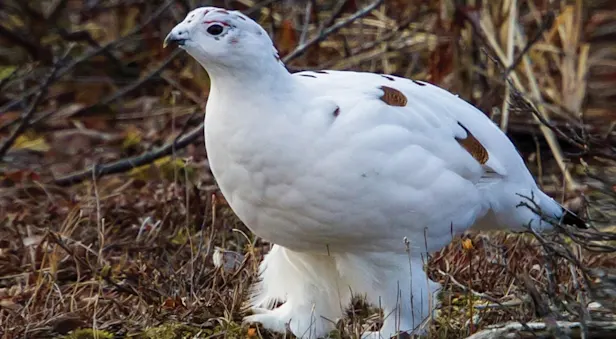
Willow Ptarmigan

Gray Wolf
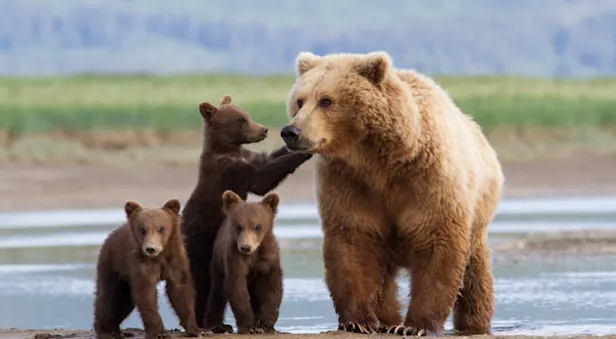
Alaskan Wilderness Trivia
Alaska Tours
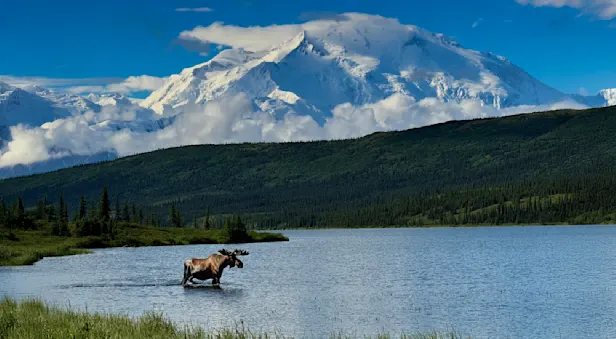
Ultimate Alaska Wildlife Safari
See more of wild Alaska on this wide-ranging, small-group adventure including Alaskan brown bears, a fly-in backcountry lodge in Denali National Park, marine life of Kenai Fjords, and the scenic Alaska Railroad to Seward.

Nat Hab's Alaska Bear Camp
A secluded immersion with brown bears in the wilderness of Lake Clark National Park—enjoy total privacy and comfort at our deluxe fly-in wilderness camp accessed via chartered bush plane from Homer.
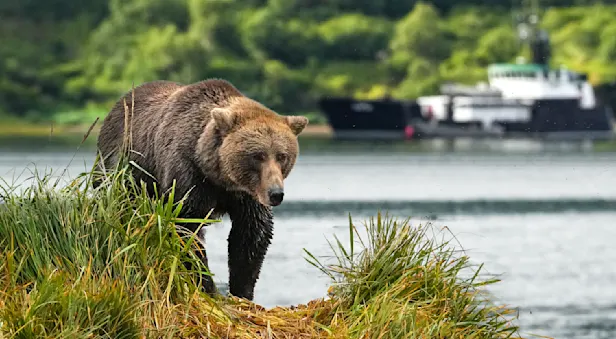
Alaska's Grizzly Ship: Kodiak to Katmai
An exclusive small-ship adventure to view giant brown bears—the world's largest "coastal grizzlies"—up close! Walk the shores as bears dig for clams, forage for sedges and pursue salmon in season in tidal streams.
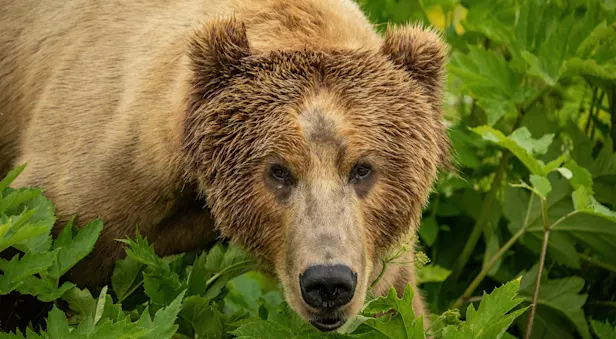
Ultimate Alaska Photo Expedition
A truly epic photography adventure! Alongside expert guides, get aerial shots of Denali from a helicopter; capture brown bear portraits at close range, and shoot glaciers, whales, puffins and more in Kenai Fjords.
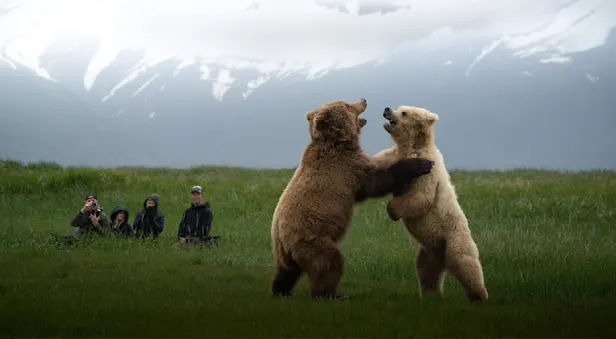
Grizzly Ship Photo Expedition: Kodiak to Katmai
Based aboard our private small ship, just eight guests photograph brown bears in the roadless Katmai wilderness, going ashore with an expert bear naturalist and photography pro who knows these animals intimately.
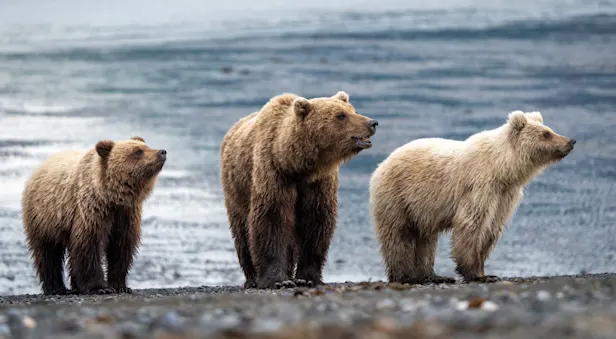
Alaska Bear Camp Photo Expedition
A secluded immersion with brown bears in the wilderness of Lake Clark National Park. Enjoy total privacy and comfort at our deluxe fly-in wilderness camp accessed via chartered bush plane from Homer.
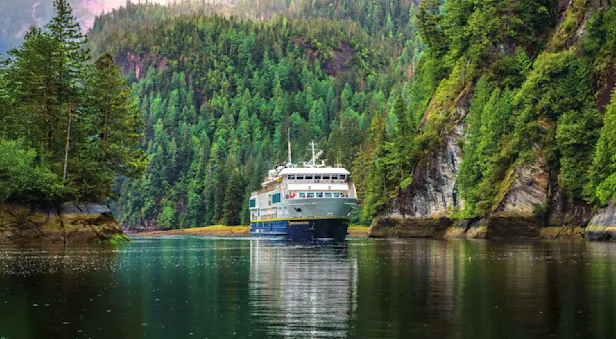
Alaska’s Inside Passage
A small-ship voyage through the narrow channels and fjords of Southeast Alaska's storied Inside Passage—meet wildlife up close in the company of top naturalists.
Wildlife Webinars
WEBINAR | Experience Ultimate Alaska: Brown Bears, Bald Eagles & More
See Alaska’s magnificent wildlife—including mighty brown bears—up close, as Expedition Leader Sam Strauss shares the details of our Ultimate Alaska Wildlife Safari. Go beyond the typical tourist tracks to reach the backcountry of Denali National Park by helicopter, ride the scenic Alaska Railroad, cruise to the face of a tidewater glacier, overnight on private Fox Island, and watch brown bears fish for salmon and rear their young. Sam also reveals other wildlife we’re likely to see, including moose, caribou, whales, otters, puffins, bald eagles—and maybe even gray wolves.
WEBINAR | Alaskan Adaptations: Wildlife & the Will to Survive
With its rainforests, rugged coastlines and abundant lakes and rivers, Alaska abounds with stunning wilderness on a scale unmatched in the Lower 48. But life in the North can be harsh! Expedition Leader Laura Geissinger reveals some of the ways Alaska’s plants and animals have adapted to survive, from megafauna like brown bears and moose to smaller creatures like Arctic terns and wood frogs to plants like arnica and bell heather. She also shares how climate change is pushing Alaska’s flora and fauna to adapt to environmental changes even faster.
WEBINAR | Otterly Remarkable: Small Creatures Making a Big Impact
Meet the small(ish) mammal with an outsized effect on marine ecosystems: the sea otter! Expedition Leader Laura Geissinger introduces us to this playful traveler favorite, from its behavior and physiology to its often-fraught history, including aggressive hunting during the fur trade era that nearly led to the species’ extinction. She also discusses how events like oil spills have impacted their recovery. Learn why this keystone species is vital to ocean ecosystems, what’s being done to protect its populations—and where you can spot sea otters on our Alaska adventures!
WEBINAR | Conservation Connect: Help Halt Mine that Threatens Alaska Brown Bears
Lake Clark National Park is home to hundreds of Alaska's iconic brown bears—the same ones we encounter at our Alaska Bear Camp! Unfortunately, their habitat is under threat from a mining interest that would devastate this pristine landscape. Nat Hab's Brooke Mitchell talks with Jennifer Woolworth, Alaska Program Manager at the National Parks Conservation Association, about the proposed Johnson Tract Mine and the impact it would have on the area. Ask questions and learn what you can do to help halt this threat to Alaska’s beloved brown bears.
WEBINAR | Power & Grace: Mastering Bear Photography in the Wild
What's your favorite animal to photograph in the wild? For many of our travelers, the answer is easy: bears! With years of bear guiding experience, Photo Expedition Director Mike Hillman shares his advice for capturing the power and grace of these majestic creatures in images. Learn what camera equipment is best for bear photography, get Mike's tips on how to anticipate bear behavior to get that once-in-a-lifetime shot, and discover how to use your surroundings to enhance your photo composition.
WEBINAR | Journey Into Alaska’s Bear Country
Alaska’s giant brown bears are some of the most awe-inspiring mammals on Earth. Learn about these charismatic creatures, their life cycles, and the remote wilderness where we visit them on two of Nat Hab’s Alaska adventures: Alaska Grizzly Encounter and Alaska Bear Quest Photo Pro Expedition. Expedition Leader and wildlife photographer Shawn Eggleston takes us on a virtual journey into bear country and offers advice for how to get stunning photographs of bears in their natural habitats.
WEBINAR | The Romantic Lives of Bears
For bears in the northern hemisphere, summer is the season of love, meaning that travelers to North American bear-viewing hotspots like Alaska, Canada, and Yellowstone and Glacier national parks are likely to encounter some romantically inclined ursine wildlife. Join wildlife biologist Aaron Bott as he explains the reproductive biology of grizzly bears, black bears and polar bears, including mating, gestation, birthing and raising of offspring.
WEBINAR | From Cub to Adult: A Grizzly Bear’s Journey
Canadian naturalist Edward Savage takes us to the Coast Range of British Columbia to follow one bear’s life from 6-month-old cub to 7-year-old adult. In this webinar, he covers the life of one female grizzly in detail, sharing photos and stories of Amber, who today is almost 8 years old.
WEBINAR | The Umbrella Bear: How Protecting Bears Protects Ecosystems
As “umbrella species,” bears help protect a whole range of animals and plants that depend on them to thrive within an ecosystem. Learn why bears are conservation heroes with Expedition Leader Edward Savage.






